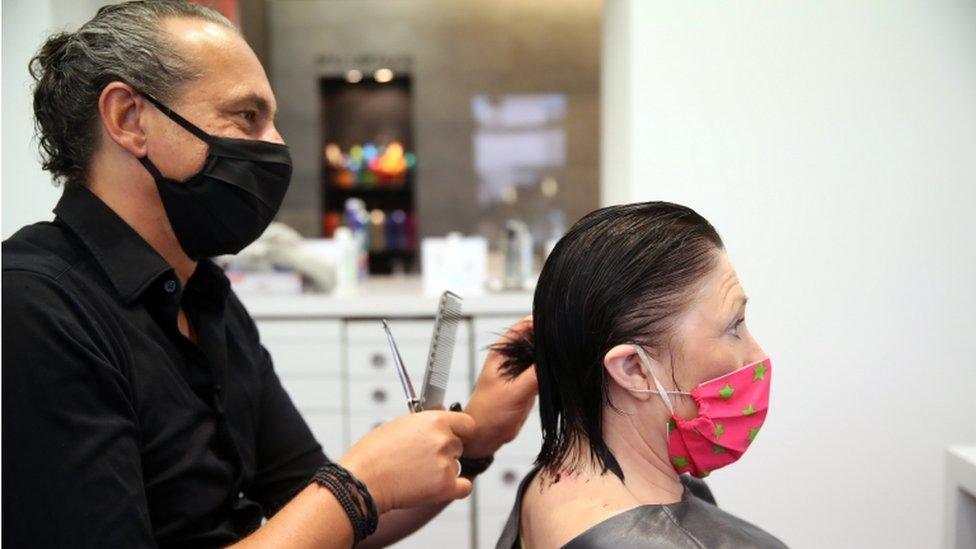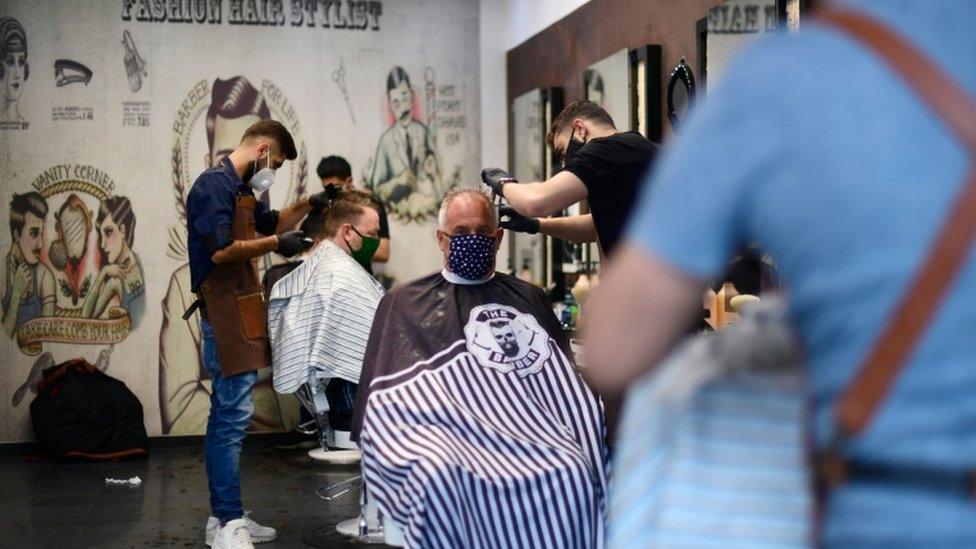Coronavirus: How to open a hairdresser's after lockdown
- Published

New rules say workers and customers must wear face masks in Germany's hairdressers
Germany has become the latest country to relax its coronavirus quarantine rules, but across Europe, hairdressers are feeling their way out.
No waiting area, no magazines, no dry cuts, and face masks for both customer and hairdresser.
Salons in Germany can now open for the first time since lockdown began on 23 March but it's not business as usual.
The rules issued by the German ministries for economy and for social affairs also include 1.5m (4.9ft) distance between customers and ideally no blow-dry.
Gloves must be worn until a customer's hair is washed (to remove any bacteria) but can be removed for the cut itself.
And the famous salon catch-up? That's gone too.
No talking face to face, the rules say - any communication about cut or colour must be done via the mirror and kept to a minimum.
The regulatory body says the rules are necessary, external because by its nature hairdressing is intimate.

When vanity trumps fear
By Damien McGuinness, BBC News, Berlin
How do most people's hairstyles look at the moment? I ask Reno Harms, co-owner of Harms hairdressing salon in the leafy Berlin district of Prenzlauer Berg. "Pretty funny. Lots of people have cut their own hair. Some have been colouring it themselves. We're doing mostly repair work today," he says, laughing.
During the six-week closure his regular customers bought vouchers to be redeemed later - something that many Berliners are doing to help their favourite local shops, cafes and restaurants. That amounted to around 50% of usual revenue, and kept his business afloat.
But that also means Reno has mostly been working for free today, as people redeem their vouchers. The new regulations mean he can only take about half his usual number of customers. Everything needs to be disinfected between clients and there are strict social distancing rules.
There's certainly no shortage of business though. In many salons in Berlin it can be difficult to get an appointment. In the weeks before the lockdown in March about half of his customers cancelled because they were afraid of being infected with Coronavirus. Reno gets the impression that people remain nervous. But they are all still clamouring for an appointment he says. "Vanity is definitely greater than fear," he jokes.

Hairdressing brings customers in much closer contact with workers than retail, the organisation explains.
Salons also have to record the names of their customers so that contact tracing of infections can take place if necessary.
Across Europe, hairdressers have been among the first businesses allowed to open when lockdown restrictions have been eased.

Customers must be 1.5m apart from each other in salons
In Spain, hairdressing salons also re-open on 4 May but must run at a maximum of 30% normal capacity and by appointment only.
When the reopening of salons was announced in Denmark on 17 April, one of the largest online booking systems crashed, which one newspaper put down to the high volume of unkempt citizens desperate for a cut.
But how easy are these rules to follow and how might they change our haircuts?
Alison Badrick is a self-employed mobile hairdresser in Buckinghamshire, England, and is still awaiting guidance from the UK government about how she can get back to work. She worries that it could still be some time.
She says most of the rules sound sensible but are challenging to follow, particularly cutting a customer's hair while they're wearing a face mask.

Salons must wash gowns after each use under the new rules
The mask's string will get in the way of cutting layers or cutting hair near the ears, she explains: "Unless they produce a mask that sticks on the face, I don't know how that's going to work."
In Germany, the head of the Hairdressing Association told TV news programme Tagesschau that customers would be able to briefly unloop the face mask from their ears and hold the mask over their mouth.
Whether getting a haircut was a relaxing or a stressful experience before the pandemic, it seems likely that post-lockdown, it will look very different.
Social distancing rules will mean salons can't serve as many clients per hour - London salon group Blue Tit estimates its shops will be working at 50% their usual capacity.
The company plans to allow an extra 15 minutes after each client to enable thorough cleaning, and hopes to increase opening hours and split staff into two shifts.
Its salons focus on sustainable hair care, and it hopes to still be able to provide "some key luxuries" including head massage, shampooing and drinks service.
Whatever new measures are introduced by the government when the time comes, it seems clear that costs will increase.
"We will incur more costs with longer appointment times, as well as the cost of PPE [personal protective] equipment but the safety of our customers and staff is the priority here," Blue Tit explains.
And what about the haircut gossip?
"The thing about hairdressers is we do talk - it's what make a hairdresser," Mrs Badrick says.
"A lot of what makes the experience of having your hair done is the chat. It's going to be interesting to see what happens," she adds.

Germany's new rules:
Cuts are by appointment only to avoid customers waiting in the salon
Customers and hairdressers must keep a 1.5m distance except when the haircut is taking place
Customers and hairdressers must wear face masks
"Direct communication" is not permitted - discussion about hair style, colour etc must be done via a mirror and kept to a minimum
No blow-drying, if possible
Fresh air must be circulated, which the rules specify should be 100m3/h per hairdresser
Scissors and other tools must be thoroughly disinfected between uses, as well as hairdressing chairs
Hairdressing cloaks must be washed after each use and, if possible, a disposable cloak should be worn over the top
Customers must wash their hands when entering the salon
Source: Berufsgenossenschaft für Gesundheitsdienst und Wohlfahrtspflege